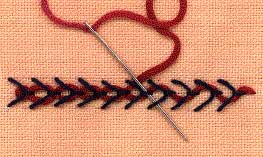Threaded fly stitch
part of the Fly stitch family

![]() Threaded fly stitch produces a branched line with a central braid like section.
Threaded fly stitch produces a branched line with a central braid like section.
First work a foundation row of fly stitch.
A second contrasted thread is then threaded as illustrated.
As you move from stitch to stitch do not pass the needle through the ground fabric. Use a blunt ended tapestry needle for this part of the process to avoid splitting the foundation running stitches.
The thread that you use to weave with can be of a different weight or sheen or a specialized thread such as a metallic, fine ribbon, fine cord or use a thread of contrasting colour and experiment with contrasts of texture, sheen and weight.
In Crazy quilting or for further decoration beads or French knots can also be added to the central loop in the threading for a more decorative effect. Beading can run down the spine of the stitch or from each spine. It is an interesting stitch to use in your needlework.
As a hand embroidery stitch it has many possibilities for interesting hand work such as use on borders or built up into a pattern.
Varieties of Fly stitch
There are a number of varieties and developments of Fly stitch. These are listed under Closed fly stitch, Plaited fly stitch, Reversed fly stitch, Threaded fly stitch, Threaded reversed fly stitch, Whipped fly stitch, and Whipped reversed fly stitch.
